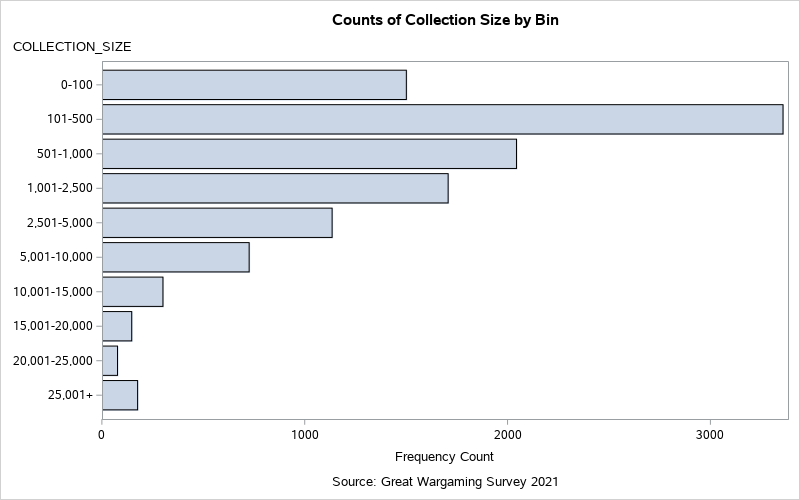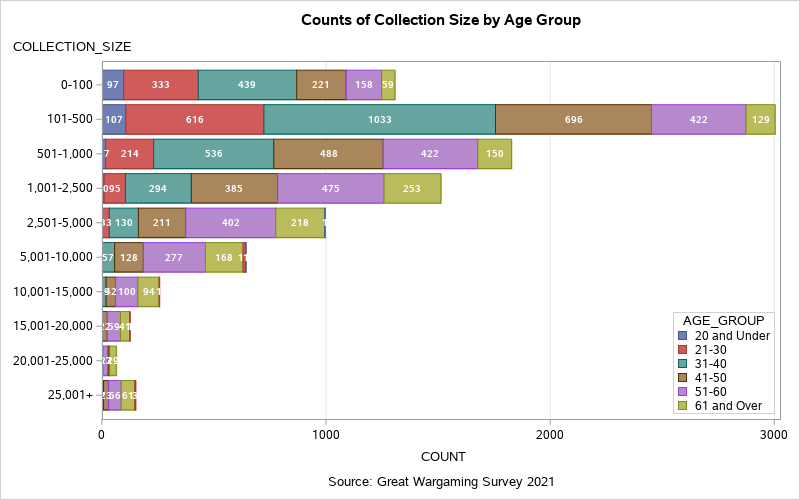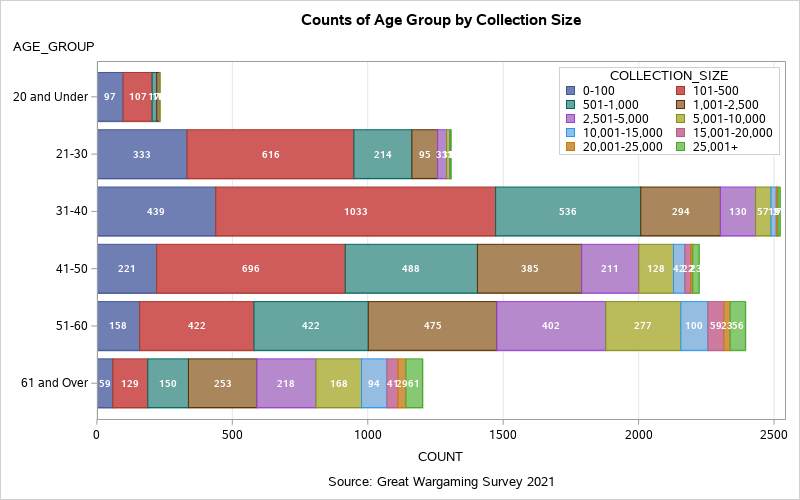GWS 2021: I've got more painted minis than you!
Measuring and assessing collection size is complicated. One of the survey questions asked in the Great Wargaming Survey 2021 (GWS2021) was:
How many painted figures do you have in your collection?
How many respondents actually know the size of their miniatures’ collections? Even when the contents of a collection are known, how are they counted? How does one define one figure? Is a cavalry trooper and mount one figure or two? Is a chariot with crew and team one figure or many? For me, it depends on the number of crew and team but I always count a chariot as more than one, but a cavalryman and his horse as a single figure. To paraphrase Donald Rumsfeld:
 Figure 1: total responses to the question about collection size[/caption]
Looking at overall bin counts, the 101-500 collection size is the most chosen bin again in 2021. Consistency is good. Note that a lot of activity and variation occur in the 2,501 and above bins. These details were masked in the 2020 survey. Still, a small bump is present in the 2021 25,001+ category. See Figure 1.
Figure 1: total responses to the question about collection size[/caption]
Looking at overall bin counts, the 101-500 collection size is the most chosen bin again in 2021. Consistency is good. Note that a lot of activity and variation occur in the 2,501 and above bins. These details were masked in the 2020 survey. Still, a small bump is present in the 2021 25,001+ category. See Figure 1.
 Figure 2: collection size compared to age group[/caption]
When these data are transposed such that counts of Age Group by Collection Size are examined (Figure 3) rather than by Collection Size and Age Group, we see that collection size tends to increase with age group. The 31-40 age group is actually the largest group for collection sizes of 1,000 figures or less. The age group 51-60 appears to holds rein as the largest collection group for collection sizes above 1,000 figures.
[caption id="attachment_71859" align="aligncenter" width="450"]
Figure 2: collection size compared to age group[/caption]
When these data are transposed such that counts of Age Group by Collection Size are examined (Figure 3) rather than by Collection Size and Age Group, we see that collection size tends to increase with age group. The 31-40 age group is actually the largest group for collection sizes of 1,000 figures or less. The age group 51-60 appears to holds rein as the largest collection group for collection sizes above 1,000 figures.
[caption id="attachment_71859" align="aligncenter" width="450"] Figure 3: Collection size per age group[/caption]
If Figure 3 is changed from count based to percentage based then tendencies are more readily apparent. In Figure 4, notice that the number of respondents having collection sizes of 1,000 figures or less tends to decrease with age while the number of respondents with collections sizes of more than 1,000 figures increases with age. Also notice that collection size diversity increases with age. While the 21-30 age group has almost 90% of its collections in the three bins under 1,001 figures, the 61+ age group counts 90% of its collections in the seven bins under 15,001.
[caption id="attachment_71860" align="aligncenter" width="450"]
Figure 3: Collection size per age group[/caption]
If Figure 3 is changed from count based to percentage based then tendencies are more readily apparent. In Figure 4, notice that the number of respondents having collection sizes of 1,000 figures or less tends to decrease with age while the number of respondents with collections sizes of more than 1,000 figures increases with age. Also notice that collection size diversity increases with age. While the 21-30 age group has almost 90% of its collections in the three bins under 1,001 figures, the 61+ age group counts 90% of its collections in the seven bins under 15,001.
[caption id="attachment_71860" align="aligncenter" width="450"] Figure 4: age group collection size in percentages[/caption]
Although these results illustrate that some aging gamers are content with capping their collections at a particular size or jettisoning collections as the lifecycle unfolds, collection sizes continue to grow as time marches on for others. I find myself firmly entrenched in the latter. Where do you find yourself along this Collection Size vs Age Group spectrum?
In the next installment of GWS2021 analyses, the study of collection size continues with a look at another attribute or two as I build up to a multi-dimensional analysis to tie it all together.
Figure 4: age group collection size in percentages[/caption]
Although these results illustrate that some aging gamers are content with capping their collections at a particular size or jettisoning collections as the lifecycle unfolds, collection sizes continue to grow as time marches on for others. I find myself firmly entrenched in the latter. Where do you find yourself along this Collection Size vs Age Group spectrum?
In the next installment of GWS2021 analyses, the study of collection size continues with a look at another attribute or two as I build up to a multi-dimensional analysis to tie it all together.
There are known knowns. There are known unknowns. But there are also unknown unknowns.Some wargamers may keep detailed logs of their collection. These wargamers know what they have. Some may know roughly their collection size, but are aware their data and memory are incomplete. These wargamers know their information is incomplete, but may have a rough idea as to collection size. Some may not even know that they do not know the size of their collections. These wargamers may have great difficulty in even assessing this question with a modicum of accuracy.
Estimating is hard!
An anecdote following from the 2020 survey brings this light to this situation. One respondent answered last year’s survey with a collection size estimate of 5,000 figures. After discussing collection sizes and how I myself track collection size, the respondent dove into the task of tallying all of his painted figures and entering them into a database. The result after this, likely, multi-week effort? Well, he came up with a collection size of about 20,000 figures! He had under-estimated the size of his collections by 75%! How many others are in similar situations? Plenty, I bet. The size of one’s miniatures’ collection likely is governed by a variety of attributes. Some of these attributes include a wargamer’s age, interest, budget, figure size, storage space, etc. Now, the survey may not consider all of these contributing attributes, but the results can provide insight for some. In the 2020 survey, counting bins for painted figure collections were:- Less than 100 painted figures
- 101- 500 painted figures
- 501- 1,000 painted figures
- 1,001- 2,500 painted figures
- 2,501+ painted figures
- Less than 100 painted figures
- 101- 500 painted figures
- 501- 1,000 painted figures
- 1,001- 2,500 painted figures
- 2,501- 5,000 painted figures
- 5,001-10,000 painted figures
- 10,001-15,000 painted figures
- 15,001-20,000 painted figures
- 20,001-25,000 painted figures
- 25,000+ painted figures
 Figure 1: total responses to the question about collection size[/caption]
Looking at overall bin counts, the 101-500 collection size is the most chosen bin again in 2021. Consistency is good. Note that a lot of activity and variation occur in the 2,501 and above bins. These details were masked in the 2020 survey. Still, a small bump is present in the 2021 25,001+ category. See Figure 1.
Figure 1: total responses to the question about collection size[/caption]
Looking at overall bin counts, the 101-500 collection size is the most chosen bin again in 2021. Consistency is good. Note that a lot of activity and variation occur in the 2,501 and above bins. These details were masked in the 2020 survey. Still, a small bump is present in the 2021 25,001+ category. See Figure 1.
Collection Size vs Age Group
What do these data show when examining Collection Size by Age Group? To begin, in Figure 2, note that the 31-40 age group makes up the largest component of the largest collection bin size of 101-500 painted figures. About 50% of respondents hold collections of 500 figures or fewer while about 77% of all respondents have collections of 2,500 figures or less. [caption id="attachment_71858" align="aligncenter" width="450"] Figure 2: collection size compared to age group[/caption]
When these data are transposed such that counts of Age Group by Collection Size are examined (Figure 3) rather than by Collection Size and Age Group, we see that collection size tends to increase with age group. The 31-40 age group is actually the largest group for collection sizes of 1,000 figures or less. The age group 51-60 appears to holds rein as the largest collection group for collection sizes above 1,000 figures.
[caption id="attachment_71859" align="aligncenter" width="450"]
Figure 2: collection size compared to age group[/caption]
When these data are transposed such that counts of Age Group by Collection Size are examined (Figure 3) rather than by Collection Size and Age Group, we see that collection size tends to increase with age group. The 31-40 age group is actually the largest group for collection sizes of 1,000 figures or less. The age group 51-60 appears to holds rein as the largest collection group for collection sizes above 1,000 figures.
[caption id="attachment_71859" align="aligncenter" width="450"] Figure 3: Collection size per age group[/caption]
If Figure 3 is changed from count based to percentage based then tendencies are more readily apparent. In Figure 4, notice that the number of respondents having collection sizes of 1,000 figures or less tends to decrease with age while the number of respondents with collections sizes of more than 1,000 figures increases with age. Also notice that collection size diversity increases with age. While the 21-30 age group has almost 90% of its collections in the three bins under 1,001 figures, the 61+ age group counts 90% of its collections in the seven bins under 15,001.
[caption id="attachment_71860" align="aligncenter" width="450"]
Figure 3: Collection size per age group[/caption]
If Figure 3 is changed from count based to percentage based then tendencies are more readily apparent. In Figure 4, notice that the number of respondents having collection sizes of 1,000 figures or less tends to decrease with age while the number of respondents with collections sizes of more than 1,000 figures increases with age. Also notice that collection size diversity increases with age. While the 21-30 age group has almost 90% of its collections in the three bins under 1,001 figures, the 61+ age group counts 90% of its collections in the seven bins under 15,001.
[caption id="attachment_71860" align="aligncenter" width="450"] Figure 4: age group collection size in percentages[/caption]
Although these results illustrate that some aging gamers are content with capping their collections at a particular size or jettisoning collections as the lifecycle unfolds, collection sizes continue to grow as time marches on for others. I find myself firmly entrenched in the latter. Where do you find yourself along this Collection Size vs Age Group spectrum?
In the next installment of GWS2021 analyses, the study of collection size continues with a look at another attribute or two as I build up to a multi-dimensional analysis to tie it all together.
Figure 4: age group collection size in percentages[/caption]
Although these results illustrate that some aging gamers are content with capping their collections at a particular size or jettisoning collections as the lifecycle unfolds, collection sizes continue to grow as time marches on for others. I find myself firmly entrenched in the latter. Where do you find yourself along this Collection Size vs Age Group spectrum?
In the next installment of GWS2021 analyses, the study of collection size continues with a look at another attribute or two as I build up to a multi-dimensional analysis to tie it all together.
